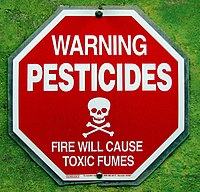
Photo from wikipedia
Neonicotinoids are a widely used class of pesticides. Co-exposure to neonicotinoids and other classes of pesticides can exert potentiating or synergistic effects, and these mixtures have been detected in human… Click to show full abstract
Neonicotinoids are a widely used class of pesticides. Co-exposure to neonicotinoids and other classes of pesticides can exert potentiating or synergistic effects, and these mixtures have been detected in human bodily fluids. The present review summarizes studies into the effects of neonicotinoid-containing pesticide mixtures on humans and other nontarget organisms. Exposure to these mixtures has been reported to result in reproductive and hormonal toxicity, genotoxicity, neurotoxicity, hepatotoxicity, and immunotoxicity in vertebrates. Mortality of pollinators and toxicity in other organisms has also been reported. The underlying mechanism of pesticide mixture toxicity may be associated with impairment of cytochrome 450 enzymes, which are involved in metabolizing pesticides. However, a comprehensive explanation of the adverse effects of neonicotinoid-containing pesticide mixtures is still required so that effective prevention and control measures can be formulated. Environ Toxicol Chem 2020;00:1-10. © 2020 SETAC.
Journal Title: Environmental toxicology and chemistry
Year Published: 2020
Link to full text (if available)
Share on Social Media: Sign Up to like & get
recommendations!